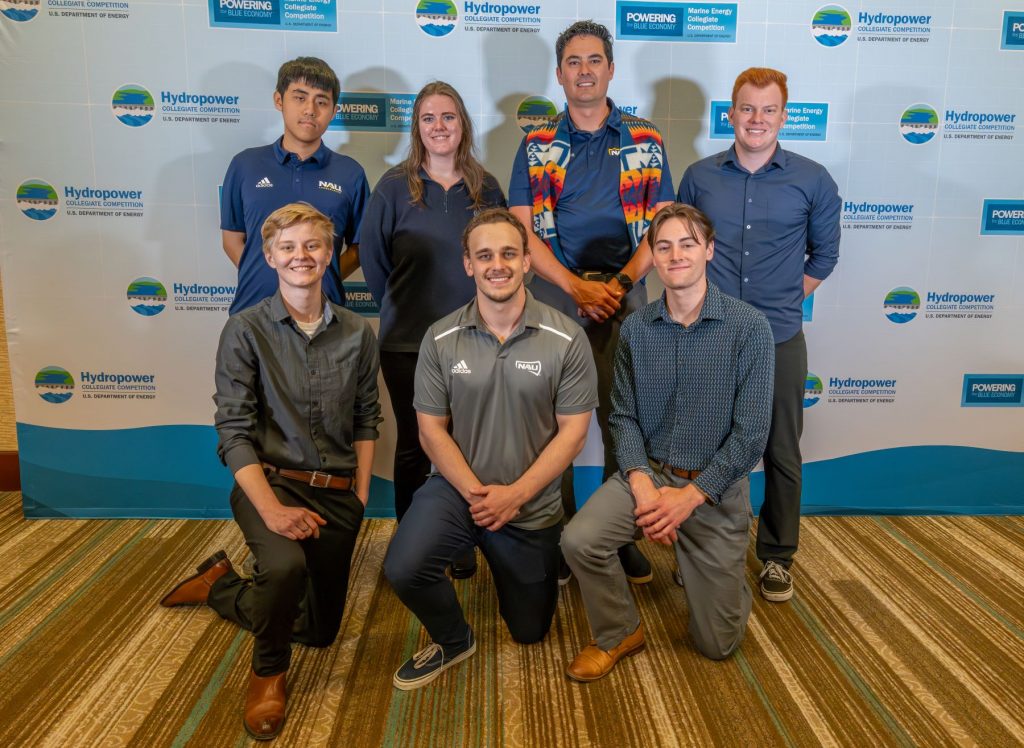This month, an interdisciplinary team of engineering students from NAU won a national hydropower competition sponsored by the U.S. Department of Energy. The competition required teams to create solutions to real-world hydropower challenges, helping them gain industry exposure and an advantage in their future clean energy careers.
Mechanical engineering students Riley Frisell, Trevor Dale and Evan Higgins and electrical engineering students Winston Steele, Evie Melahn and Zonghua Ouyang took first place in three separate challenges and first overall in the Hydropower Collegiate Competition (HCC) in Iowa earlier this month. All six students participated as part of their senior capstone projects and graduated this month—their competition success marking an exciting end to their NAU careers.
“As a mechanical engineering student, my passion for solving complex problems and advancing sustainable development has been enriched by my experience in the HCC,” said Higgins, the team lead, who will begin his career working for a wastewater company where he has previous experience as an intern. “Although my immediate post-graduation career will be in water/wastewater, this competition has really broadened my perspective on renewable energy, and I enjoyed the result of the work my team and I did this year.”
The HCC, in its second year, challenges students to form an interdisciplinary team, work together to do research on potential dam sites, create a conceptual design for a hydropower system and conduct community outreach on the value of hydropower. The goal is to give students experience in the industry and pathways to different hydropower careers while fostering a greater understanding among the students and their communities about hydropower’s role as an underutilized source of clean energy.
The three phases of the competition
This year, the competition challenged teams to develop a viable way to convert an existing non-powered dam (NPD) into a productive hydropower facility that produces up to 10 megawatts of power—enough to power hundreds or thousands of homes. They did this in three phases:
1. The Siting Challenge: Teams performed a site selection process and developed a feasibility assessment for the site.
NAU’s team evaluated more than 300 NPDs throughout the country, eventually landing on Kentucky River Lock and Dam No. 4. The students chose this site because the dam’s existing infrastructure would allow for a cost-effective conversion while causing minimal environmental disruption.
2. The Design Challenge: Teams created a conceptual design of their site or completed a final design for a component or system related to their site.
The students provided a conceptual design, equipment selection, drawings and facility analyses for a unique system, developed in partnership with Voith Hydro, which combined an in-river turbine with on-site solar panels.
3. The Community Connections Challenge: Teams conducted outreach with the hydropower industry and a community of their choosing.
NAU’s team met with industry professionals and teachers and determined that the best way to develop a stronger renewable energy workforce was to get young people thinking about STEM careers early. They presented at one of Willow Bend’s Science Saturdays, tabled at Flagstaff’s KidWind Challenge and gave a teaching presentation to sixth graders at STAR School—a completely off-grid public charter school adjacent to the Navajo Nation.
“As college students, we served as related role models, bridging the gap between young students and more distant figures like teachers,” said Higgins, adding that the team valued the opportunity to inspire and motivate a new generation of future engineers.
In the end, NAU shone in all three challenges, beating out teams from Johns Hopkins University (which tied with NAU for first place in the community connections challenge), Cal Poly State University, Columbia University, Texas Tech University and others. Higgins credited their success to the team’s strong working relationships with each other and to partnerships with organizations such as the NAU Energy Club and the Collegiate Wind competition.
“I’m grateful that it was this specific interdisciplinary group that came together this year. This was 100% a team effort.”
Heidi Toth | NAU Communications
(928) 523-8737 | heidi.toth@nau.edu
Jessica Clark | NAU Communications
jessica.clark@nau.edu




